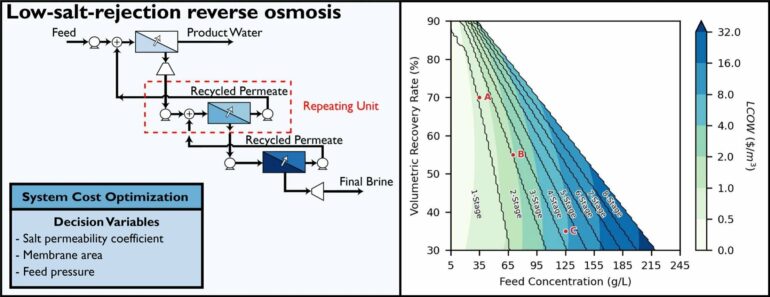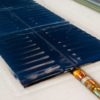As climate change flames a megadrought in the U.S. Southwest, the country is hitting some worrisome records. The water level of Lake Mead, which provides water for millions of people, is hovering near its lowest ever. And in some places, the shrinking Colorado River, which irrigates about 5 million acres of farmland and quenches the thirst of over 40 million people, is just desert and dust.
Meanwhile, as of 2018, about 80% of the country’s wastewater—including water used in agriculture, power plants, and mines—gets dumped back into the world, untreated and unusable, a wasted opportunity. And although today’s go-to purification technologies, which use a process called reverse osmosis, are still the most cost-effective and energy-efficient way to treat seawater and briny groundwater, conventional reverse osmosis cannot handle super-salty waters—those containing double the salt content of the ocean. As U.S. water supplies shrink (and get saltier), the country can no longer afford to dump even the saltiest sources back into the world.
Now, in a new study published in Desalination, members of the National Alliance for Water Innovation (NAWI) research consortium analyzed an emerging form of reverse osmosis, called low-salt-rejection reverse osmosis. These novel systems could treat even highly salty water. But the design is so new it is still theoretical.
So, to learn how these technologies might compete with other water treatment options, the NAWI research team developed a mathematical model that could, with help from a supercomputer, quickly evaluate the cost, clean water output, and energy consumption of more than 130,000 potential system designs. Their results show that, in many cases, low-salt-rejection reverse osmosis could be the most cost-effective choice, potentially reducing the overall cost of producing clean water by up to 63%.
“The ultimate goal of this research is to conduct a thorough techno-economic evaluation of a new technology that hasn’t been tested in the real world yet but has the potential to enable high-water-recovery desalination,” said Adam Atia, a senior engineer at the National Energy Technology Laboratory and the paper’s lead author.
Although a few studies have evaluated the potential cost and efficiency of low-salt-rejection reverse osmosis systems, this study offers a more comprehensive analysis of their design, operation, and performance. To better understand the potential promise of these theoretical systems, the team used a supercomputer to hone in on the most optimal, cost-effective designs. They then explored how those designs might function in hundreds of thousands of scenarios (as opposed to just a handful).
Because low-salt-rejection reverse osmosis systems allow more salt to pass through each membrane, they require less force—and therefore less energy—to push the water through. But, if more salt can squeeze through, the resulting water is, not surprisingly, still too salty to drink. To produce potable water, this still-too-salty water gets recycled back into the previous membrane stages. Once the salt content is low enough, standard reverse osmosis can take care of the rest, generating high-quality drinking water.
All that recycling adds to the system’s complexity. So, the team needed to find out: How many membrane stages are optimal? How many recycling loops are needed? And how much cost and energy do those loops add? To answer these questions, researchers could calculate, individually, how much clean water each design could produce from waters with different concentrations of salt.
“That would potentially take a really, really, really long time for them to solve,” said Ethan Young, a researcher at the National Renewable Energy Laboratory (NREL) and an author on the study. “We were able to do it in a few minutes with high-performance computing.”
And, in those few minutes, they examined not one but hundreds of thousands of potential scenarios.
“The novelty of our study is the computational force power we brought to bear on this analysis,” added Bernard (Ben) Knueven, a fellow NREL researcher and author.
Without a supercomputer, all those calculations would take about 88 days instead of one hour or even a few minutes, Young said. Of course, the supercomputer also needed Knueven and Young’s mathematical magic to solve these complex design problems both quickly and accurately.
With all that speedy math, the team discovered that low-salt-rejection reverse osmosis could outperform its competitors in both cost and energy use—at least for water containing less than 125 grams of salt per liter. But the team’s model could also help other research teams identify, build, and test the most promising system designs.
“The hope is, by doing these computational analyses, we can give the experimentalists information to say, ‘Oh, here’s an interesting thing to study,’ or, ‘No, this is probably completely ruled out,'” Knueven said.
The model could be expanded, too, to help experimentalists hone in on the best designs for reverse osmosis systems, generally. Their study is the first to both use and add to NAWI’s Water treatment Technoeconomic Assessment Platform (WaterTAP). A publicly available software tool, WaterTAP gives users the power to model and simulate various water treatment technologies and evaluate their cost, energy, and environmental trade-offs.
“I think it’s so cool. We’re building a tool that can help us and other researchers assess the potential of new and exciting technologies,” Knueven said of WaterTAP, which was built through a collaboration between NREL, Lawrence Berkeley National Laboratory, the National Energy Technology Laboratory, Oak Ridge National Laboratory, and the Regents of the University of California.
Next, the researchers hope to partner with experimental teams to build and evaluate how low-salt-rejection reverse osmosis systems function in the real world. Mineral buildup, for example, could slow the system down and should be accounted for in future evaluations.
Even so, Atia said, this emerging form of reverse osmosis could be a valuable tool to maximize water recovery from high-salinity sources. “And our model can play a key role in supporting the technology’s deployment,” he said.
“To me,” Knueven said, “it’s a demonstration of what we can do with a little bit of computation and a little bit of optimization.”
More information:
Adam A. Atia et al, Cost optimization of low-salt-rejection reverse osmosis, Desalination (2023). DOI: 10.1016/j.desal.2023.116407
Provided by
National Renewable Energy Laboratory
Citation:
New water treatment technology could help recycle even super salty waters (2023, May 16)



